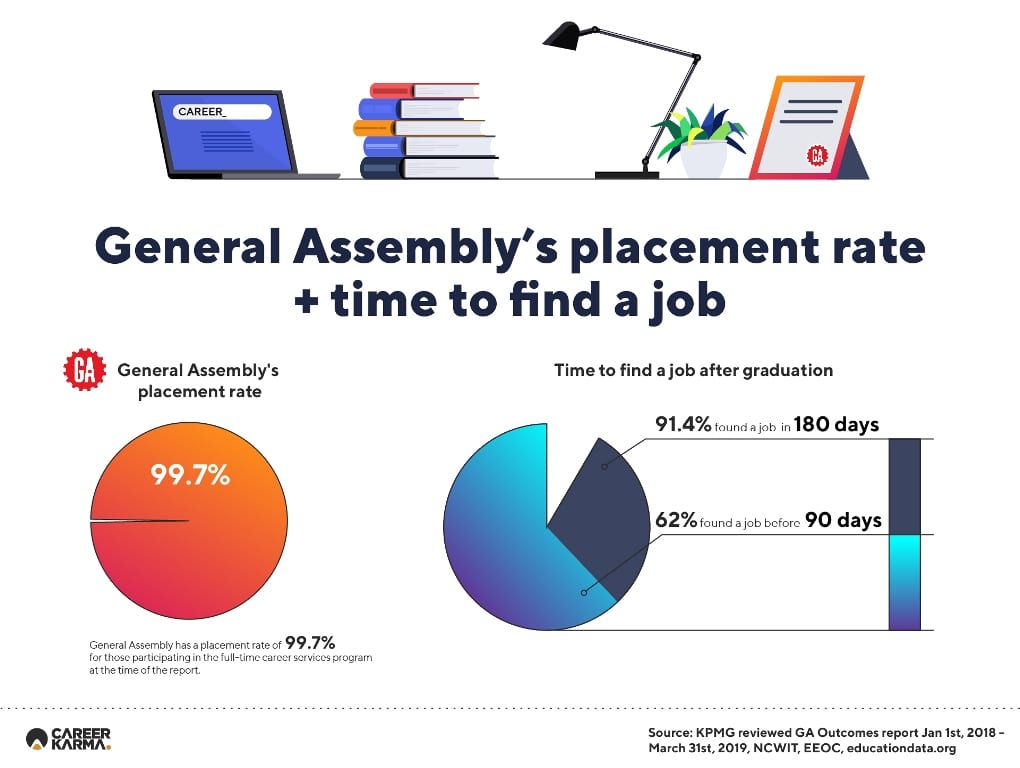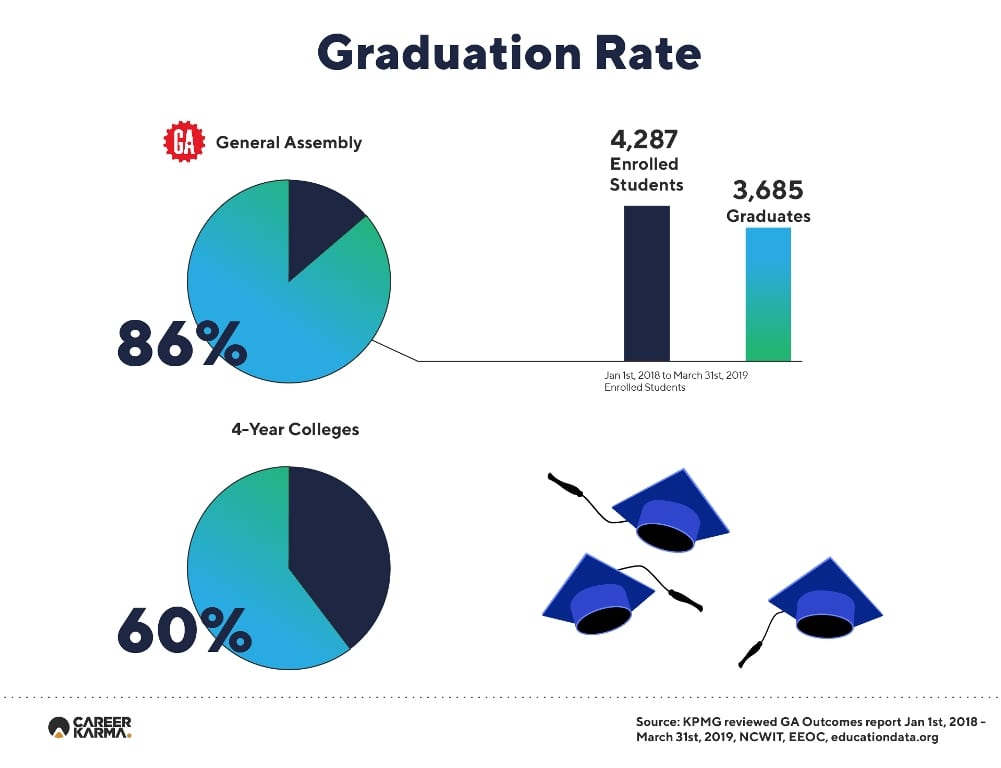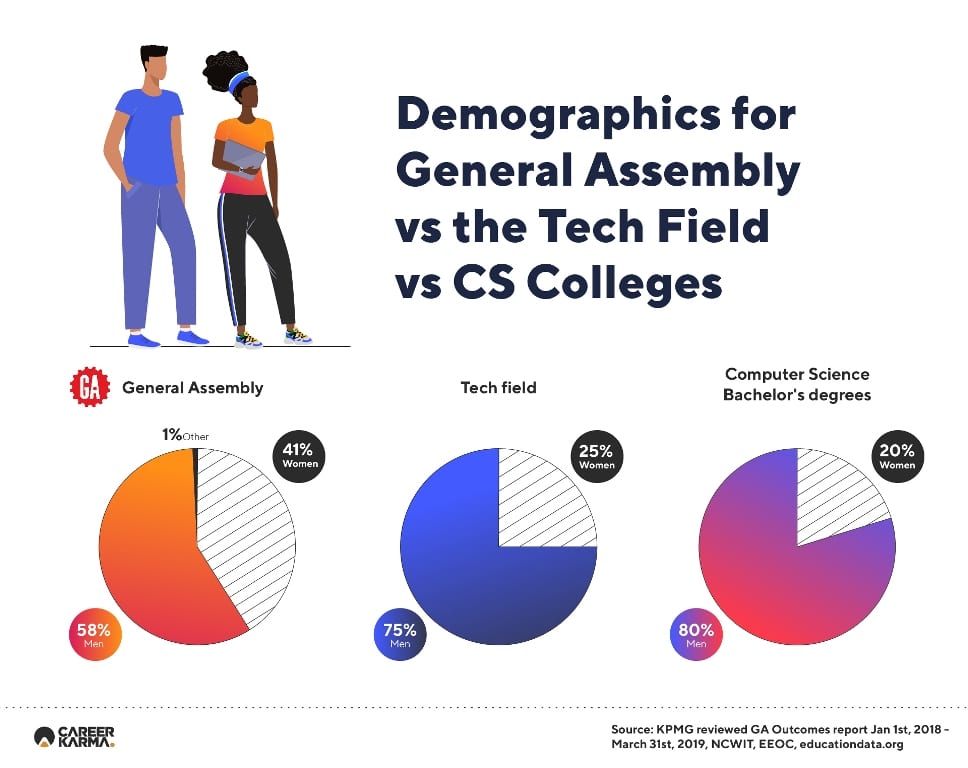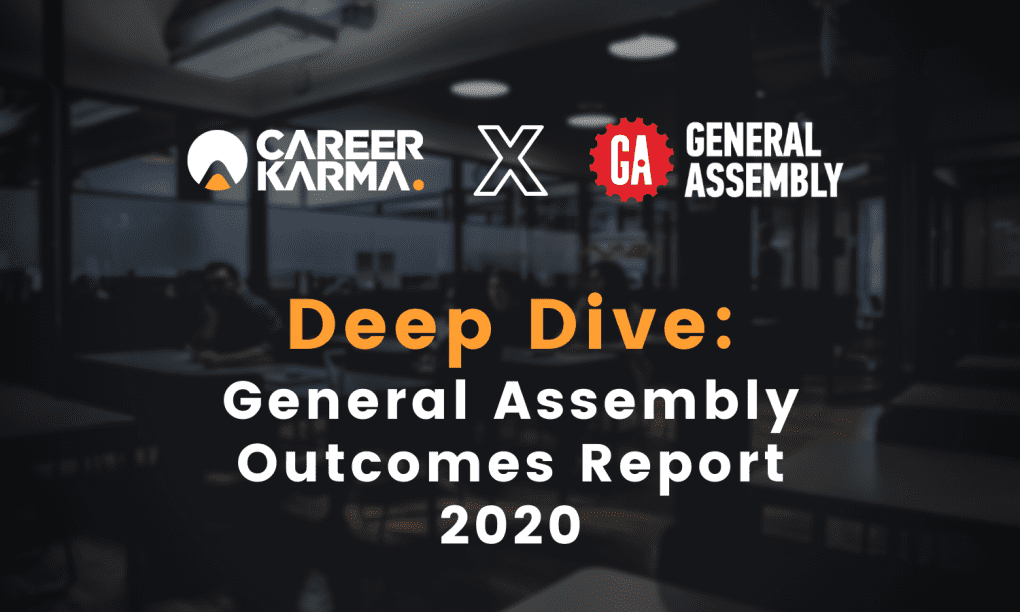If you’ve decided to switch into a career in technology—or if you’ve decided to step up your current career—the next step is to figure out where to learn new tech skills.
Unlike many career fields, there is a wealth of options for learning the skills needed to start or enhance a tech career. Nearly every coding school or bootcamp will promise a high-paying job after graduation, but the sad truth is that not all of these schools are created equal.
It’s important to find a program that not only works for you, but that will also give you the best chances of finding success in your job search. While student testimonials are useful for understanding the culture and environment of any school, they are ultimately only one person’s story.
Fortunately, there’s a reliable metric we can use to find a quality coding bootcamp: data. Some schools have released outcome reports, which are internal metrics on graduates that are typically verified by a reliable third party. Looking at the data provided in these reports can give us an honest look at what happens to students after graduation.
In this article, we’ll be taking a deep dive into General Assembly’s 2020 outcomes report. Highlights include a 99.7% job placement rate for those participating in an outcomes program at the time of the report (with 91.4% within 180 days) and a high graduation rate of 86% when compared to traditional education. We’ll also look at student demographics, student funding, and education level to see how General Assembly looks when held up to the light. We’ll also discuss what those numbers mean to you, and every other potential student.
General Assembly – Overview

Starting as a coworking space in 2011, General Assembly has become one of the largest and most well-known coding bootcamps. The school hosts 39 in-person campuses across the globe, from Minneapolis to Melbourne, as well as an online campus. It’s seen over 12,000 graduates from its full-time programs succeed in launching new careers over nearly ten years.
The school’s self-stated goal is to ‘close the skills gap’ in the tech industry, attempting to supply the rapidly growing demand for qualified professionals in the sector.
General Assembly provides a career services program for full-time program students that includes a one-on-one career coach for each student, who provides job search help throughout the course and after graduation. The career services program is of note because those who stuck with it proved to be able to land a new job in their field of study, as we’ll learn later in the article.
General Assembly Courses and Careers
General Assembly has two types of paid courses: full-time Immersive programs and part-time programs. The outcomes study focuses on the immersive programs, so we will only touch on these. The full course list can be found on General Assembly’s website.
The full-time immersive programs in the report include 400-500 hours of training over 12 weeks—though this timing is now more flexible with the launch of the flex program—and the award-winning curricula are taught by experienced professionals in the field of study.
Software Engineering Immersive
The Software Engineering Immersive course (originally named Web Development Immersive, it was renamed after the report after adding new content focused on computer science) covers front-end and full-stack development while teaching technologies like JavaScript, React, Python, Django, and more. This course is designed for anyone looking to get into web development, though it is a great jumping-off point for many development environments.
User Experience Design Immersive
The User Experience (UX) Design Immersive course teaches industry-relevant skills and standards for UX design, such as wireframing, user research, and usability testing. UX design is an exciting blend of tech, creativity, and psychology, and is an industry that’s growing nearly as fast as software development.
Data Science Immersive
In the Data Science Immersive program students can expect to learn modern and practical data science skills like Python, data analysis, machine learning, and neural networks. Data science is not only a cutting edge profession but an in-demand one as well.
General Assembly Outcomes Report
Before we dig in, there are a few important notes to cover, including the criteria for the report.
Report criteria
The report was compiled using information from 4,287 students who attended any of the three above mentioned courses which ended between January 1, 2018 and March 31, 2019.
This study does not cover any of the part-time non-immersive programs. It is inclusive of every campus offering full-time immersive programs during this reporting period, including Atlanta, Austin, Boston, Chicago, Dallas, Denver, London, Los Angeles (Downtown and Santa Monica), Melbourne, New York City, Online (Remote), Providence, San Francisco, Seattle, Singapore, Sydney, and Washington, D.C.
The Student Outcomes and Demographics, including graduation rates and job placement data, are reviewed by KPMG, a Big Four Accounting firm.
General Assembly Career Job Placement Program
Many of the figures below are dependent on whether students followed a job placement program. Most graduates of General Assembly’s Immersive programs participate in the job search process full-time after their program, dedicating 30+ hours/week to the search. However, General Assembly recognizes that a portion of their graduating population has other needs in their life—such as health challenges or the need to work part-time after the program—that didn’t allow them to participate in the full-time search. These graduates are able to continue with General Assembly’s job search program as Extended Seekers, with the understanding that their job search may take longer due to the shift in job search output.
The vast majority of the students in the figures below belong to the full-time job seekers category, close to 94%. For simplicity, the numbers below focus primarily on these full-time job seekers. The full report can be found here.
Placement Rate

The most relevant metric is likely the placement rate, which describes how many students found a job after graduation. Of the 2,652 students who participated in the job placement program after graduation, 91.4% achieved an outcome in 180 days after graduation and a total of 99.7% had landed a job at the time this report was published. This number is outstanding, and breaking it down will give us a few insights.
Of the 2,652 students that stuck with the placement program, only 8 did not find a job by the end of the reporting period. The vast majority of these jobs are full-time positions, with only 1.7% of these students accepting a part-time position. In addition, 2,283 (91.4%) of these students found a job within 180 days of graduation, and more than half of these students found a job within three months. Including the time required for the course itself, this means a nine-month wait at most between starting school and finding a job.
Nine months is a short period of time for a full career change. In comparison, career changers that attend a college or university to learn a new skill take years to start a career in their chosen field. Keeping this in mind, students that apply to change their careers need to be sure that they can sustain for that long before finding a job.
It’s worth noting that of the 4,287 students in the report, 602 students did not graduate, and 1,032 did not complete the career services program. However, many of these students opted out for clear reasons—like to continue their education or return to their previous job—and only a little over half were unresponsive or non-compliant with the career services program.
As we can see, nearly every student that stuck to this program found a full-time job in their field of study. Following this valuable program can almost guarantee a full-time job while dropping out of the program does not.

Finally, considering the number of students that did not complete their course is useful. 14% of students in the study dropped out, which is significantly lower than the enormous 40% dropout rate found in US colleges. However, this does not mean the immersive courses are easy. The full-time intensive programs offered by General Assembly require a dedication that not every student has.
Education
An oft-overlooked figure when considering bootcamp reports is the level of education of students before starting a full-time program. Over half of the students in the study had a bachelor’s degree, and another 16% held a higher degree title. Another 18.2% had some level of college education or an associate’s degree, and only 4.5% of students had a high school diploma or GED alone.
These numbers are telling; we could assume that the many students holding a bachelor’s degree were not able to get the practical education they needed to enter the field. General Assembly’s courses rounded out their education with practical skills needed to kickstart their career in tech.
Funding
The tuition for the immersive courses in this study ranged from $13,950 to $15,950. General Assembly provides multiple options for students to pay tuition.
A little over 57% of students paid through self-funding. Self-funded means the student provided money upfront by their own means, whether taking out a personal loan, borrowing money from friends or family, or paying out of pocket.
Nearly 24% of students paid via the loans offered through General Assembly’s partners. Only 2.5% of students paid for school with an Income Sharing Agreement (ISA), which is a system where students pay 10% of their future income after finding a job for 48 months. However, this number is expected to expand as General Assembly receives regulatory approval from more US states.
Finally, almost 14% of students joined with a full scholarship or government funds. These students came from a place of financial need, and the majority of them came from underrepresented groups in tech.
It’s important to consider that though the majority of students paid for the course upfront, the best payment option is the one that fits your financial situation.
Demographics
While not as immediately useful as the above figures, having information on the demographics of General Assembly students gives us some insight into what kind of environment is fostered by the school. The figures below only reflect those who elected to respond to these questions.
Less than half of the students in this study identified themselves as white, with the larger group students identifying as other ethnic groups, including East Asian, Southeast Asian, Black or African American, and Latin American.
More than 41% of students identified as women, 58% identified as men, and an additional 1% that identify as another gender. The majority of students—over 61%—were between the ages of 25-34. The youngest student was 18, and the oldest student was 74.

While having a student body that is half male and half white may not seem impressive, compared with the current demographics in the tech field they are an accomplishment.
Only 26% of people working in the tech field identify as women as of 2019, a number that’s been in decline since 1991. In addition, 63.5% to 68.5% of tech employees in 2014 were white, and 83.3% of tech executives were white according to the EEOC.
These numbers look even better when compared with traditional education, where women made up a dismal 21% of graduates from computer science bachelor’s degrees in 2019.
These numbers mean that General Assembly’s courses are inclusive and produce a welcoming environment for students of any race or gender. They are also helping the tech field become more diverse, something the sector is in desperate need of.
Numbers in the Global Market
It’s helpful to give the above numbers some context by comparing General Assembly with the bootcamp market.
According to Career Karma’s State of the Coding Bootcamp Market Report for 2020, nearly 34,000 students graduated from 105 bootcamps in 2019, General Assembly included. This makes GA’s 4,287 students an enormous chunk of the market (even though the study covered more than one year).
In addition, General Assembly is one of only 27 bootcamps out of the 105 in the study that offered income share agreements in 2019.
Conclusion
In the above review, we’ve discovered how General Assembly is a market-leading bootcamp for a reason. Its effective outcomes process, placement rate, and diversity all make the school an attractive choice for those looking to switch to a career in tech, or those in the field looking to pick up a new skillset.
While the tech field career landscape has changed drastically since this report was published—the impact of COVID-19 is still making waves in the industry—the demand for qualified tech professionals isn’t going anywhere, and the training GA provides is more relevant than ever.
General Assembly has made the application process straightforward and personable. You can submit a quick form on their website to speak to their admissions and find out more about their courses, career support, and scholarships here.
About us: Career Karma is a platform designed to help job seekers find, research, and connect with job training programs to advance their careers. Learn about the CK publication.




